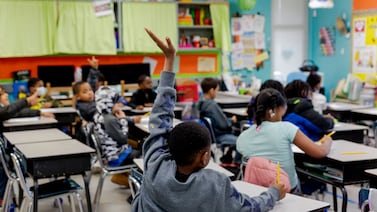Indiana’s 2023 legislative session is under way, and state legislators have introduced more than 100 new education bills and bills impacting schools and students. For the latest Indiana education news, sign up for Chalkbeat Indiana’s free newsletter here.
A proposal to require all Hoosier high schoolers to take a personal finance course is moving forward, amid a spate of legislation aimed at improving students’ financial literacy.
Senate Bill 35 — one of five bills that would make personal finance a graduation requirement — mandates that schools offer a stand-alone course on topics like opening a bank account, applying for loans, and filling out tax returns. High schoolers would be required to take the class beginning with the Class of 2028.
The bill, authored by GOP Sen. Mike Gaskill, unanimously passed out of the Senate Education and Career Development committee Wednesday.
The vote puts Indiana on track to join several other states that have recently adopted financial literacy graduation requirements. However, some lawmakers and others questioned if the bill would create an additional burden for schools, or if the principles of financial literacy could instead be incorporated into other courses.
A total of 17 other states, including Michigan and Ohio, now require such a course for graduation, according to a report from Next Gen Personal Finance. The report also found that nationwide, schools where a majority of students are students of color — as well as those where most students receive federally subsidized meals — were far less likely to have a guaranteed personal finance course than whiter and wealthier school districts.
A mandate for such courses isn’t entirely new to schools in the state. Around 11% of Indiana students are currently enrolled in schools that require a semester-long course dedicated to personal finance, according to Next Gen Personal Finance’s report.
Another Indiana bill would allow students to meet a current graduation requirement to take Algebra II by taking a personal finance course instead.
Testimony from a committee hearing on the bill last week highlighted the necessity of such a course.
“Who’s to know what financial influences may challenge our students in the year 2030?” said Bob Taylor of the Indiana Association of School Superintendents. “To have a solid foundation of financial literacy is going to be critical for them to continue to be lifelong, articulate, intelligent consumers.”
A financial literacy bill has been expected since the Interim Study Committee on Education recommended the measure last fall. At that time, Democratic Sen. Shelli Yoder expressed some concern that math teachers would be tasked with teaching financial literacy while also trying to help students recover from pandemic-era academic setbacks.
Other lawmakers have asked if the bill would create an undue burden for schools.
Gaskill said that the Indiana Department of Education could decide to adjust another mandate to make room for this requirement, but that personal finance is important enough to merit its own class.
A one-semester course that exclusively covers personal finance is the ideal format, J.W. Fansler of the Indiana Council for Economic Education said, because it allows schools to reach all students just as they may be starting their first jobs.
Integrating personal finance into existing courses is possible, but presents issues, he said. Incorporating it into an economics course conflates two separate subjects, for example, while adding it to math classes might be tricky with high schoolers on different math tracks.
The class should cover budgeting, including tracking expenses like car and house payments, insurance costs, and utility bills, Fansler said. To teach this, some schools have turned to “reality stores,” in which students choose an occupation and learn how much they’ll make on average, and then spend their projected paychecks on both necessities and discretionary costs.
“A lot of students are surprised at how much things cost,” Fansler said of their reaction to personal finance education. “They think: I’m going to make $15 an hour — but wait — $15 an hour doesn’t go as far as I thought it would.”
Overall, creating a personal finance graduation requirement is good for Indiana students, and the state as a whole, Fansler said.
“Financial stress is one of the top stressors. If they can decrease that, it’s going to make their job performance improve, their relationships better,” he said. “If they’re job prepared, they’ve learned about discipline, it’s going to make their lives better.
Correction: This story has been updated to reflect the number of states that require financial literacy as of 2023, as well as the link to the most recent Next Gen Personal Finance report.
Aleksandra Appleton covers Indiana education policy and writes about K-12 schools across the state. Contact her at aappleton@chalkbeat.org.






